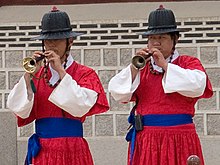Taepyeongso
| Taepyeongso | |

Taepyeongso players playing in front of the Gyeongbokgung
|
|
| Korean name | |
|---|---|
| Hangul | |
| Hanja | |
| Revised Romanization | taepyeongso |
| McCune–Reischauer | t'aep'yŏngso |
The taepyeongso (lit. "big peace wind instrument"; also called hojok, hojeok 호적 , nallari, or saenap, ) is a Korean double reed wind instrument in the shawm or oboe family, probably descended from the Persian zurna and closely related to the Chinese suona. It has a conical wooden body made from yuja (citron), daechu (jujube), or yellow mulberry wood, with a metal mouthpiece and cup-shaped metal bell. It originated during the Goryeo period (918 – 1392).
The loud and piercing sound it produces has kept it confined mostly to Korean folk music (especially "farmer's band music") and to marching bands, the latter performed for royalty in the genre known as daechwita. It is, however, also used sparingly in other genres, including Confucian, Buddhist and Shamanist ritual musics and neo-traditional/fusion music.
Written sources in English are scarce. The instrument is mentioned and discussed briefly in a number of books, such as those produced by the National Center for the Traditional Korean Performing Arts, which introduce Western readers to Korean music and culture. Nathan Hesselink's Pungmul (2006) devotes a few paragraphs of background to the instrument, as does Keith Howard’s Korean Musical Instruments: A Practical Guide (1988). Lee Byong-Won’s Buddhist Music of Korea (1987) provides brief analyses of taepyeongso playing in Buddhist ceremonial music and dance, as well as some important details about the players.
Maria Seo, in Hanyang Gut (2002), and Lee Yong-Shik in Shaman Ritual Music in Korea (2004), provide some context for taepyeongso playing in shaman rituals. Keith Howard has an interesting, although speculative, discussion on daechwita—royal processional music usually featuring two taepyeongso in Bands, Songs and Shamanistic Rituals (1989), and further context for taepyeongso in court music is provided by Song Kyong-Rin in “Korean Musical Instruments” (in Survey of Korean Arts: Traditional Music, 1973).
...
Wikipedia
